Arson as a(nother) redevelopment strategem
A few weeks ago there was an article in the Washington Business Journal about what a burden historic preservation is. See "Tied to history." I meant to write a letter but I was too busy, but Rebecca Miller, director of the DC Preservation League, did do so.
Over the years I've joked with reporters from the WBJ that they write for the Journal of Record for the Growth Machine. There is no question that the paper covers development--the #1 local business in the Washington region--from the perspective of developers. Still, some of the writers do endeavor to be more than mere mouthpieces or press release conduits... I wouldn't say that was the case for the the above-mentioned piece.
From the article:
Since as far back as 1998, the Anacostia Economic Development Corp. has tried to tear down the Martin Luther King Jr. Avenue building and replace it with a mixed-use project that would serve as a catalyst for new development in the blighted Southeast. Court battles and disagreements with the city's historic preservation board are to blame in part for the delays. But finding well-heeled tenants that will help the Anacostia group recoup its expenses on the project has been equally as difficult, said Butch Hopkins, the development group's president and CEO.
For getting a sense about how "community" development corporations have an agenda that can be disconnected from neighborhood development, see this blog entry: Falling up -- Accountability and DC Community Development Corporations.
The reality is that DC has five competitive advantages, three tied to historic preservation:
1. Historic architecture;
2. Place-positive urban design/livability/walkable neighborhoods;
3. History, authenticity, and identity;
4. A rich transit infrastructure that allows for efficient mobility that is not dependent on the automobile;
5. The steady employment engine of the Federal Government.
Ignoring these competitive advantages through ill considered development diminishes the city.
Funny that demolition by neglect + fire was a strategy that assisted Amoco in its attempt to build a large gas station on the entire face block of the north side of the 300 block of H Street NE. (That project, for other reasons, was dropped.)
I was in Anacostia on Monday, and while rushed I took some photos, including the MLK Jr. Blvd. property, and it reminded me of the entry from 8/30/2005, reprinted below.
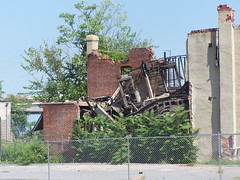
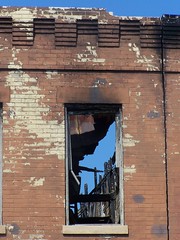
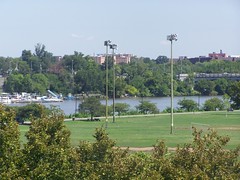
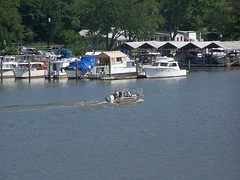
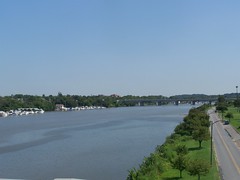
I will say that some of the new construction, of which I did not take photos, is reasonably decent, more attractive than any of the buildings constructed by the H Street Community Development Corporation on H Street NE. Maybe this is because of the decade in which it was constructed? The H Street stuff was mostly built in the 1980s, the Anacostia buildings much more recently, and currently.
------------------------------------------------------------------
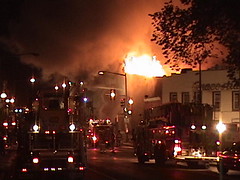
On fire--1909-1913 Martin Luther King, Jr. Blvd., Washington, DC. Fire photos from the "fire department hobbyist" website, www.dcfd.com.
-- Arson can be used to further destabilize neighborhoods. This is described in chilling detail in the book Streets of Hope about the Dudley Street Neighborhood Initiative in Boston.
-- Arson can also be used to get around historic preservation laws.
-- Arson can also be used as a tactic to get one city agency to give another city-supported agency a "problem" from the asset portfolio.
A few nights ago, some disinvested but resolute historic commercial buildings experienced a fire. Shockingly, part of the problem in putting out the fire is the fact that there wasn't water running in the fire hydrants, so that tankers had to be brought over.
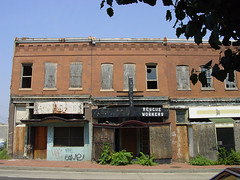
1909-1913 Martin Luther King, Jr. Blvd., Washington, DC, after the fire.
These buildings are owned by the District Government, and are in DHCD's real property portfolio. The Anacostia Economic Development Corporation has an Exclusive Rights Agreement to purchase the properties, and has submitted plans to DHCD that indicate the buildings would be incorporated into a larger redevelopment of the surrounding half-block, which has been purchased by Douglas Development. The structures are designated as "contributing" to the Anacostia Historic District, which has been identified by DC Preservation League as "threatened".
Every possible attempt be made to stabilize the remaining portions of the buildings so that they can be incorporated into the planned new development. (Mayor Joe Riley of Charleston tells a great story of rather than acceding to the Fire Department's request to demolish a historic but burned building--they stabilized the building and closed the street--and restored the building.)
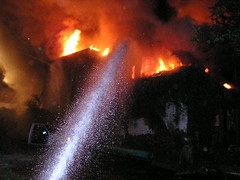
On H Street NE, four of the oldest buildings on the H Street corridor (constructed in the mid-1870s) were demolished by the local community development corporation in favor of a new building. Among other neglectful acts, these buildings did experience "fire of unknown origin."
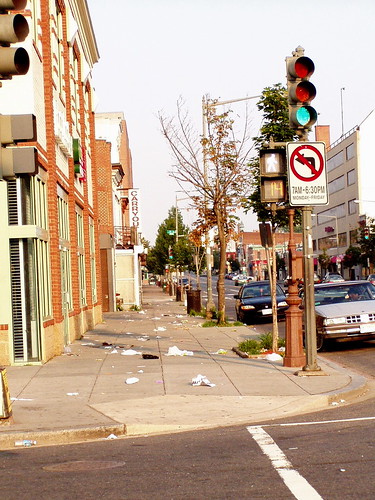
New building constructed in the place of Beuchert's Tavern and three other buildings at 721-727 H Street NE. Photo by Elise Bernard.

For decades, the corner building was the location of Club Kavakos, later the Co-Co Club, a live music establishment on the H Street corridor. Of course, this business closed after the riots. Matchbook cover scan by Peter Sefton.
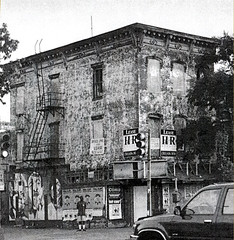
Beuchert Tavern, 727 H Street NE, pre-demolition, under the stewardship of the H Street CDC.
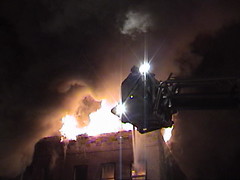
_____________
Also see my earlier blog entry: "More office buildings 'won't' save Anacostia."
Labels: urban design/placemaking, urban renewal, urban revitalization



0 Comments:
Post a Comment
<< Home